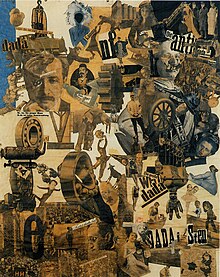 |
| Cut with the Dada Kitchen Knife through the Last Weimar Beer-Belly Cultural Epoch in Germany, 1919 Hanna Höch |
Dada activities included public gatherings, demonstrations, and publication of art/literary journals; passionate coverage of art, politics, and culture were topics often discussed in a variety of media. The movement influenced later styles like theavant-garde and downtown music movements, and groups including surrealism, Nouveau réalisme, pop art and Fluxus.
Many Dadaists believed that the 'reason' and 'logic' of bourgeois capitalist society had led people into war. They expressed their rejection of that ideology in artistic expression that appeared to reject logic and embrace chaos andirrationality. For example, George Grosz later recalled that his Dadaist art was intended as a protest "against this world of mutual destruction."
According to Hans Richter, Dada was not art, it was "anti-art." Everything for which art stood, Dada represented the opposite. Where art was concerned with traditional aesthetics, Dada ignored aesthetics. If art was to appeal to sensibilities, Dada was intended to offend. Through their rejection of traditional culture and aesthetics, the Dadaists hoped to destroy traditional culture and aesthetics.
As Hugo Ball expressed it, "For us, art is not an end in itself ... but it is an opportunity for the true perception and criticism of the times we live in."
A reviewer from the American Art News stated at the time that "Dada philosophy is the sickest, most paralyzing and most destructive thing that has ever originated from the brain of man." Art historians have described Dada as being, in large part, a "reaction to what many of these artists saw as nothing more than an insane spectacle of collective homicide."
Years later, Dada artists described the movement as "a phenomenon bursting forth in the midst of the postwar economic and moral crisis, a savior, a monster, which would lay waste to everything in its path. [It was] a systematic work of destruction and demoralization... In the end it became nothing but an act of sacrilege."
- Dada had only one rule: Never follow any known rules.
- Dada was intended to provoke an emotional reaction from the viewer (typically shock or outrage). If its art failed to offend traditionalists, Dada writing - particularly Tristan Tzara's manifestoes - proved a fine, nose-thumbing Plan B.
- Dada art is nonsensical to the point of whimsy. Almost all of the people who created it were ferociously serious, though.
- Abstraction and Expressionism were the main influences on Dada, followed by Cubism and, to a lesser extent, Futurism.
- There was no predominant medium in Dadaist art. All things from geometric tapestries to glass to plaster and wooden reliefs were fair game. It's worth noting, though, that assemblage, collage,photomontage and the use of ready made objects all gained wide acceptance due to their use in Dada art.
- For something that supposedly meant nothing, Dada certainly created a lot of offshoots. In addition to spawning numerous literary journals, Dada influenced many concurrent trends in the visual arts (especially in the case of Constructivism). The best-known movement Dada was directly responsible for is Surrealism.
- Dada self-destructed when it was in danger of becoming "acceptable".
Hiç yorum yok:
Yorum Gönder